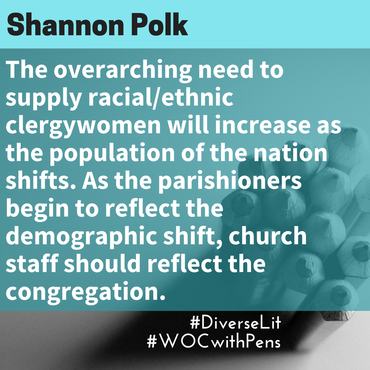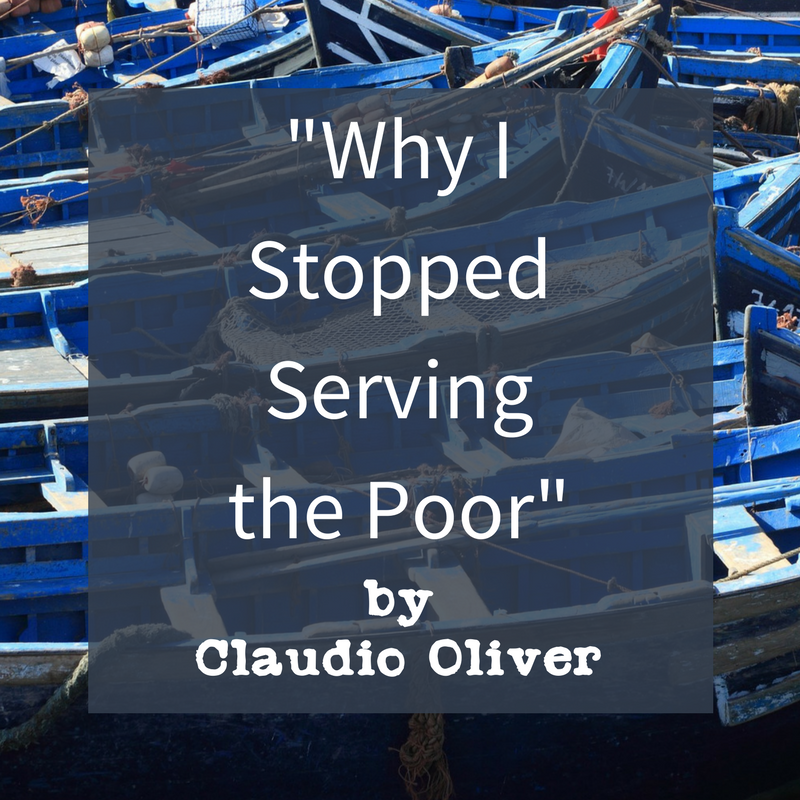 By Shannon Polk Associate Program Officer, Charles Stewart Mott Foundation, Flint, Michigan Printer Friendly Version (PDF) Originally Published For Assemblies of God Theological Seminary “The tyranny of hegemonic truth will have to be abandoned by those who treasure it and are privileged by it.” Alicia Vargas1 Everyone walks through the doors of the church with a cultural agenda believed to be normative. Often the basis of that framework begins with one’s assigned gender roles and, in America, expands to include class and race. For many people within the dominant group, other aspects of the paradigm will diminish, but that, unfortunately, is not the case for individuals without a dominant identity. Dual identity is the lens through which a woman of color sees the church. This duality structures her interactions within the ecclesiastical system, choosing neither gender nor race as the dominant framework. The duality of her presence in leadership can confuse people who may not fully accept her leadership in a cross-cultural context or who struggle with a non-male leader. Can the predominantly white Christian denominations receive the new wine that women of color in leadership have to offer? This is a variation of the question Superintendent Gilbert H. Caldwell asked of his ecclesiastical brethren around the issues of men of color leading in a predominantly white fellowship.2 Caldwell denied the myth that men of color ascend to senior levels within the administrative structure because the minority group has evolved enough to produce someone of sufficient caliber to function within that role. Instead, when men of color are elevated within the church, it is because the organization has evolved enough to allow someone outside of the hegemony to obtain a leadership seat. The hegemony commonly overlooks members of the minority group who are well-prepared for a leadership position. This is illustrated by the ascension of Beth Grant to the Executive Presbytery of the Assemblies of God (AG) and also illustrated by the election of President Barack Obama. Notwithstanding Grant’s exceptional credentials, the documented history of women within the AG Fellowship demonstrates that other women were equally qualified to lead as a member of the Executive Presbytery. President Obama’s election should not imply that he was the first man of color qualified to hold the office, but rather that it was not until the twenty-first century that the United States had evolved enough to be comfortable with a man of color at the helm. In these examples, predominantly white institutions embraced a new type of leader within the system—a Caucasian woman and an African-American man. However, strikingly absent is the person of dual identity ascending to significant senior leadership within these structures. Where are the women of color in leadership positions? Church Increase Due to Women and Minorities According to the statistics from the AG U.S. Minister’s Report, in 2008 no women served as district officials, and only eleven women served as district presbyters. Of the 6,502 credentialed women within the Fellowship, 1,316 were either retired or semi-retired. The number of active clergywomen contrasts sharply when compared to the number of female adherents. The data states that 56 percent of the adherents of the Fellowship are women, and over 1 million of the 2.8 million people who identify themselves as members of the Assemblies were non-white (Asian, African-American, Latino, native American, or of mixed heritage). The complexion and gender ratios are changing within the church because they are changing within the country. Women represent 50.7 percent of all people living in the United States.3 By 2042, white Americans will be the minority, and by 2023, the majority of school-aged children will be children of color.4 These census statistics, combined with the internal data collected by the Fellowship and other denominations, should signal the need for significant change within Protestant church leadership. Women of color should be encouraged to answer the call to full-time ministry. The church must prepare for racial/ethnic clergywomen in an intentional manner. Within the Assemblies of God, several affinity groups based on a variety of ethnic distinctions exist for people of color. Additionally, the Network for Women in Ministry provides data, encouragement, and literature for women pursuing the call of Christ. While the 2008 Conversations speakers deliberately represented a plenary view of women in ministry, the lack of diversity among the conference attendees was rather striking. It would be interesting to interview women of color who attended Conversations 2008 and other conferences for racial/ethnic affinity groups and review the qualitative responses of the participants to understand how each environment ministers to their needs. Local districts should promote these affinity groups to clergy aspirants as a method of finding affirmation and building collegial relationship with other ministers who share an aspect of their duality. Without these relationships, racial/ethnic clergywomen may become isolated in an unhealthy manner and, subsequently, leave the field in pursuit of more comfortable surroundings. I Make Much of My Ministry—but I Could Use Some Help! Senior leadership must explore what institutional support systems are necessary for cross-cultural and female appointments. Typically, academic literature explores three topics: (1) assisting male leadership in cross-cultural appointments, (2) helping women in cross-gender appointments, or (3) supporting women of color as they navigate gender politics within their intra-ethnic congregations. As the national ethnic demographics shift toward a browner society and women begin to enter seminaries in increasing numbers, the leadership of predominately-white ecclesiastical institutions must begin to address the needs of racial/ethnic clergywomen from a dual identity perspective and prepare institutions for this new group of leaders. A Washington Post article about clergy of color leading predominately-white congregations highlighted pastors in Maryland and Virginia.5 The overwhelming response of the male pastors, one African-American and one Asian, indicated that because of globalization and doing God’s will, parishioners are becoming more responsive to their leadership. Conversely, while the Asian woman echoed the men’s comments, she accepts this charge as a missionary for the Lord to the white community and readily acknowledges that her congregants embraced her leadership more slowly than she had anticipated. The African-American female pastor expressed frustration at being the only person of color her parishioners know and stated that although she recognized the purpose of her work, she was simply tired of the arduous task of being the bridge-builder. Fortunately, the African-American woman and the Asian woman belong to a denomination that actively supports racial/ethnic clergywomen. In the United Methodist Church, HiRho Park led the charge for women of color clergy and serves as the Director of Continuing Formation for Ministry. As director, she helps disseminate a study of racial/ethnic clergywomen within the United Methodist Church as a means of helping the church understand the relationship between race, gender, and faith for clergywomen.6 The study examines demographic information and thematic issues such as age, length of time in placement, marital status, salary in comparison to male clergy, and their ability to ascend the denominational ladder. The findings demonstrate that married clergywomen experience less isolation than their single peers and, therefore, enjoy greater overall satisfaction. However, unlike their single counterparts, married female clergy experienced greater tension and critique regarding the dual commitment to ministry and family. When being interviewed for credentialing, married clergywomen were asked to rank their priorities between the ministry and their family—a question many clergywomen did not believe was being asked of their male counterparts. Both single and married clergywomen express dissatisfaction with their pay but remain uncertain whether the pay discrepancy was due to gender or race. The clergywomen relayed several heartbreaking examples of gender and race bias that would make any Christian weep at the thought of such repulsive and solipsistic attitudes. One Asian woman pastor discussed her shame when the ordination board required her to take accent reduction classes before placing her in a church. Her shame did not originate in the request, but upon the discovery that her Asian-born male seminarian peers were never required to take any type of speech therapy to reduce their accents. Another Latina pastor indicated that her assignments were limited to mission-style church plants or churches with limited resources. From her perspective, only Anglo men were assigned to larger suburban churches with Anglo parishioners. Racial/ethnic clergywomen desire to serve in cross-cultural congregations, despite the challenges, as long as adequate support was present. The United Methodist Church (UMC) supports its racial/ethnic clergywomen through a variety of programs. For instance, the Women of Color Scholars program was designed in response to the lack of women of color teaching in the United Methodist seminaries.7 To date, the scholarship has helped twenty-six women complete their PhDs. In addition, the UMC developed a multi-ethnic affinity group for racial/ethnic clergywomen. That affinity group, in turn, created a mentoring initiative entitled, “The Mary-Elizabeth Mentoring Program,” where a seasoned clergywoman mentors a younger female protégé.8One-on-one mentoring can provide significant guidance needed after accepting the audacious call to ministry. One additional source of assistance was a conference specifically targeting pastors of color who lead predominantly white congregations. Identifying fellow sojourners in the body of Christ can mitigate the feelings of isolation for people in Christian leadership. Although some pastors never experience issues with cross-cultural appointments, the majority of these pastors are men crossing a racial boundary or white female pastors crossing a gender boundary. As For Me and My House—We Will Look for Opportunities Certainly, the AG Fellowship embraces racial/ethnic clergywomen and endeavors to bolster support for these pioneering women through various affinity groups. As referenced earlier, The Network promotes diversity among its ranks of credentialed women. Two women represent the National Black Fellowship at the district level, but no women serve on the executive board. The twenty-first century AG Fellowship is reexamining it roots and learning that the church possesses a rich history of women of color at the helm. Jessica Faye Carter wrote an enlightening article outlining some seminal women of color who served within the Assemblies of God—each with their own story of pioneering in response to the call of God.9 These women faced the twin obstacles of gender and racial/ethnic discrimination, but they persisted in their pursuit of Christ. For example, Pandita Ramabai established a home for widows and translated the Bible into Marathi, the fourth most spoken language in India. Cornelia Jones Robertson pastored a California church for 30 years, being one of the first African-American credential holders in the Assemblies of God. Maria de Fatima W. Gomes became the general superintendent of East Timor, possibly the only woman to have ever served as the head of a national fellowship. Clearly, a phenomenal legacy exists upon which women of the twenty-first century can build. These doorways to leadership expand due to the receptivity of senior leadership. Through the encouragement of Jesse Miranda, the number of Latina ministers has increased.10George Wood has received the same approbation for his role in electing a woman to the Executive Presbytery. The broad-mindedness of the presbytery provides a pattern for tolerance on the district-level clergy. The overarching need to supply racial/ethnic clergywomen will increase as the population of the nation shifts. As the parishioners begin to reflect the demographic shift, church staff should reflect the congregation. In the interim, our predominately-white congregations and leadership structures must prepare themselves to embrace, once again, sisters who represent different cultures, languages, and customs. Let the history of the Pentecostal movement serve as a landmark that points the movement in the direction of Scripture. The Word states that our first allegiance is not to a gender or a race, but to unity in Christ.11Let the church and believers persevere to embrace that truth. *Visit Shannon's website for more about her, and follow her on Twitter @shas This article was originally submitted to Dr. Deborah Gill in partial fulfillment of the requirements for an AGTS course, “Biblical Theology of Women in Leadership.” End Notes 1. Alicia Vargas, “The Construction of Latina Christology: Invitation to Dialogue” Pacific Lutheran Theological Seminary, Currents in Theology and Mission 34 4 (August 2007): 271. 2. Gilbert H. Caldwell, “Black Folk in White Churches,” The Christian Century, February 12, 1969 3. U.S. Census Bureau: State and County QuickFacts,http://quickfacts.census.gov/qfd/states/00000.html (accessed Dec. 12, 2009). 4. U.S. Census Bureau, http://www.census.gov/Press-Release/www/releases/archives /population/012496.html (accessed Dec. 12, 2009). 5. Phuong Ny, “Minority Pastors Preach Diversity,” Washington Post, http://www.washingtonpost.com (accessed Dec. 12, 2009). 6. Jung Ha Kim and Rosetta Ross, “The Status of Racial and Ethnic Minority Clergywomen in the United Methodist Church” (Paper, General Board for Higher Education and Ministry. The United Methodist Church, Nashville, TN, 2004). 7. United Methodist Church General Board of Higher Education and Ministry, Women of Color Scholars program, http://www.gbhem.org/site/c.lsKSL3POLvF/b.4862847/k.242C/RacialEthnic_Clergywomens_ Consultation.htm (accessed December 12, 2009). 8. United Methodist Church General Board of Higher Education and Ministry, Clergywomen’s News. http://www.gbhem.org/site/apps/nlnet/content3.aspx?c=lsKSL3POLvF&b=5569805&content_id={FE421700-6784-4C8E-BC67-49DB9AE24CEF}¬oc=1 (accessed December 12, 2009). 9. Jessica Faye Carter, “Women of Color and the Assemblies of God,” Assemblies of God Heritage, vol. 28 (2008): 40. 10. Gaston Espinosa, “Liberated and Empowered: The Uphill History of Hispanic Assemblies of God Women in Ministry, 1915-1950,” Assemblies of God Heritage, vol. 28 (2008): 44. 11. Gal. 3:28, All Scriptures, unless otherwise stated, are from Today’s New International Version. Updated: Friday, June 16, 2006 10:22 AM
0 Comments
Leave a Reply. |
Gena's
|

 RSS Feed
RSS Feed

